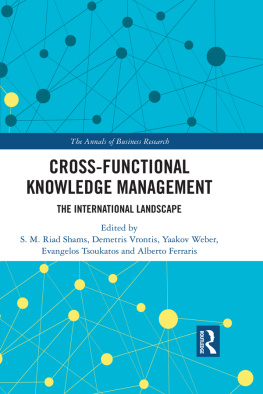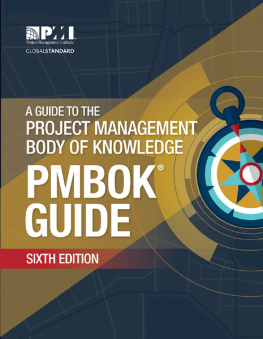We gratefully acknowledge the generous support of colleagues, who extended their hands to help us to make this book successful. We sincerely thank the contributors for their invaluable contributions. Without their disciplined effort, this book project would not have been accomplished. We would like to express our gratitude to all subject experts for volunteering in the double-blind review process. Moreover, a special thank is due to Ludovica Laddomada for her precious help. We also would like to acknowledge the friendly and supportive role of the editorial staff of Routledge. Last, but not least, we appreciate all our family members for their encouragement to make this project a success.
S. M. Riad Shams, Demetris Vrontis, Yaakov Weber, Evangelos Tsoukatos and Alberto Ferraris
Organizations all over the world have to face high risks of competition and the possibilities of losing customers. One of the most important factors that causes this problem is that the organizations have a lot of difficulties in facing the rapid changes of market trends (Del Giudice, Della Peruta, & Carayannis, 2010). Very often in different organizations, knowledge management has become the solution to this problem and, simultaneously, the key driver to create customer values (Ting Si Xue, 2017).
With the purpose of taking full advantage of knowledge management, organizations must have a clear understanding on how knowledge is formed (Ipe, 2003; Van den Hooff & Huysman, 2009), in particular in a global scenario. In fact, in an international landscape KM gains crucial knowledge from both inside and outside of the organizations for different reasons such as improving service quality by providing faster service response time (Edvardsson & Oskarsson, 2011; Ha, Lo, & Wang, 2015; Bresciani, Ferraris, & Del Giudice, 2016).
Nowadays, knowledge is one of the most valuable key sources of competitive advantage in different organizations, but in order to fully take advantage of critical knowledge, organizations should explicitly manage it. In fact, Knowledge Management (KM) is the systematic management of vital knowledgeand its associated processes of creation, organization, diffusion, use and exploitation (Skyrme, 2001). Its importance has been recognized for a long time in many and different streams of business management research (Grant, 1996). Within the literature, knowledge management has been analyzed from a multitude of angles. A lot of studies have been conducted in the private sector while less research has been done in the public sector (e.g. Willem & Buelens, 2007).
According to Hackbarth (1998) the main goal of KM is to improve innovation and responsiveness in the exchange of information, in particular inside the organization. Davenport and Prusak (1998) showed that most knowledge management projects have one of three aims: (1) to show the role of knowledge in an organization and to make the process visible; (2) to promote a culture of intensive knowledge by encouraging and aggregating behaviors such as knowledge sharing and proactively seeking; (3) to create a knowledge infrastructure and not only a technical system, understood as a connection between people, given space and time.
In general, novel cross-disciplinary knowledge plays an important role in business management also if we look at the relevance in managing knowledge that resides within and also outside (through networks) firms boundaries. This book develops different insights for the management of knowledge in cross-functional business areas to originate an innovative approach to the classical knowledge management (KM) field, in order to underpin research and practice in the wide area of business management.
Some authors defined knowledge as (1) a state of mind, (2) an object, (3) a process, (4) a condition of having access to information, or (5) a capability (Schubert, Lincke, & Schmid, 1998; McQueen, 1998). Specifically, as a state of mind, knowledge allows individuals to expand their personal knowledge and apply it to the organizations need (Schubert, et al., 1998). As an object, it can be viewed as something to be stored and manipulated. As a process, knowledge can be viewed as a trial of simultaneously knowing and acting (McQueen, 1998), where knowledge enables acting by applying expertise. As a condition of having access to information, the focus of knowledge is to facilitate access to and retrieval of contents (McQueen, 1998). In this case, knowledge is conceived as the capability to use information to make decisions.
Even though knowledge can be classified at the level of individuals or groups, internal or external to firm boundary, hard or soft, practical or theoretical, the most common and well-known taxonomy is the tacit vs. explicit (Nonaka, 1994; Pathirage, Amaratunga, & Haigh, 2007). Tacit knowledge, according to Mooradian (2006) and Grant (2007), is something personal, an ability, a skill to do something, which is partially based on peoples own experiences, and this is one of the key aspect of KM. Explicit knowledge can be documented, codified and shared, can be stored in digital systems and technological ways, and it is transferable. It can be achieved, collected, transformed, shared, communicated with ease and be accessible to people. This type of knowledge is typically more prevalent in organizations (Joia & Lemos, 2010; Huang, Davison, & Gu, 2011).
Tacit knowledge is difficult to be evaluated and accessed, is less familiar and it creates the background necessary for assigning the structure to interpret and improve explicit knowledge (Polanyi, 1975). Tacit knowledge is different from explicit knowledge as it is usually shared in drawings or writing. Nonaka, the father of this stream of literature, argued that knowledge is formed through the interactions of tacit and explicit knowledge (Nonaka, 1994). Snchez et al. (2012) added that very often tacit knowledge is meaningless without explicit knowledge, because both types of knowledge are complementary and essential for knowledge creation.
Knowledge can be measured in many different ways within organizations. People employed hold knowledge, known as tacit knowledge, in their minds (Davenport, De Long, & Beers, 1998). Tacit knowledge is hard for others to use, and represents knowledge that is influenced by personal experiences, which are shared when employees meet and share their knowledge in the organization. This kind of knowledge is made up of experiences, information, values and systematic attitudes that provide a proper framework for evaluation of new information and experience. New knowledge is created when employees within the organization share their own knowledge, either tacit or explicit (Hooff & Hendrix, 2004), and this is known as knowledge sharing, which is one of the main core processes beyond KM.
Nowadays, the tacit-explicit knowledge classification has become too superficial, because there are many other classifications of knowledge that try to identify useful distinctive knowledge in organizations with a more pragmatic approach. Examples include knowledge about competitors, heuristics rules, products, processes, customers etc. Different authors (Alavi & Leidner, 2001) coined some very famous types of knowledge.
- Individual: knowledge made and deep-seated in the individual;
- Social: knowledge made and deep-seated in the collective group and their actions;
- Declarative: know-about;
- Procedural: know-how;
- Causal: know-why;
- Conditional: know-when;
- Relational: know-with;
- Pragmatic: the essential knowledge for organizations.
The interest in KM has increased over time, becoming a relevant issue in the late 1980s. KM is a way for organizations to take care of all the existing knowledge within the organization. However, the definition of knowledge management is not easy to identify. Today, we still have the tendency to use the term knowledge to describe information systems and databases. In reality, more attention is paid to technological infrastructures that allow the passage of information rather than real knowledge and the transfer of it between people (Nonaka, 1994).






